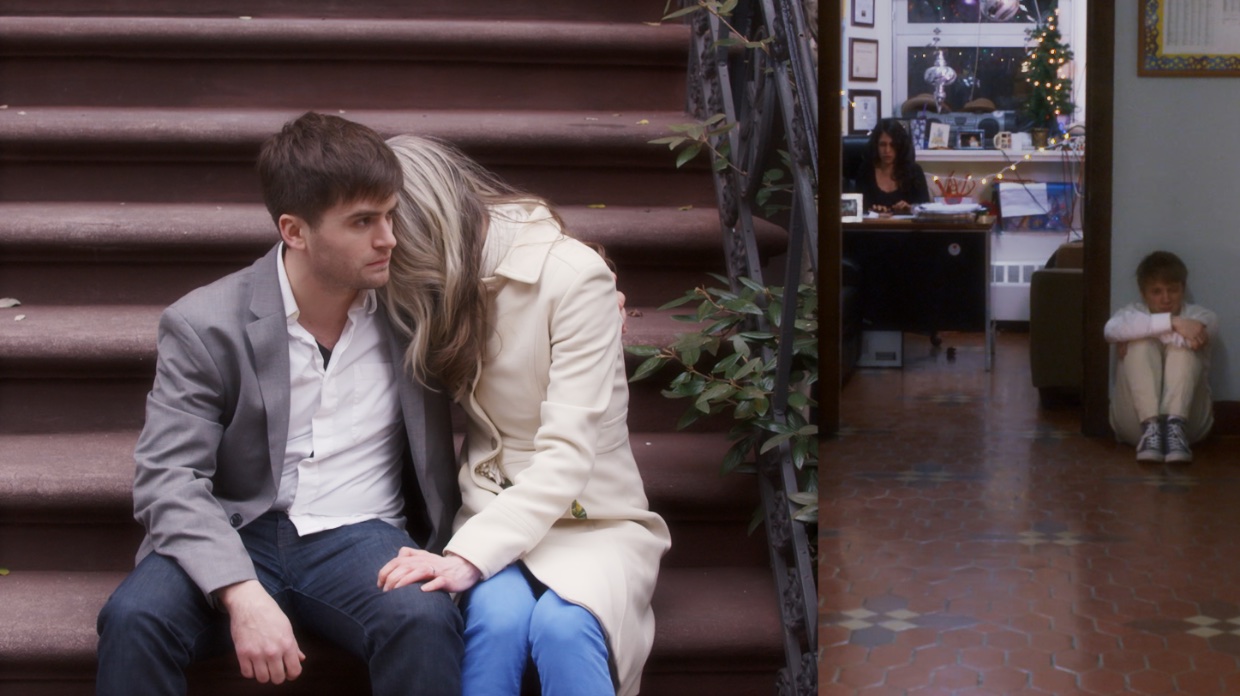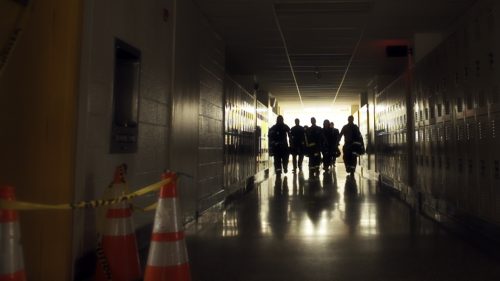 Back to selection
Back to selection
How the Numbers Add Up: The Director of 42 Seconds of Happiness and The Rainbow Experiment Explores the Numerology of Filmmaking
 The Rainbow Experiment
The Rainbow Experiment Christina Kallas’ tense ensemble drama 42 Seconds of Happiness received a number of awards last year in regional and international festivals in the U.S. and abroad, granting her, among other accolades, a nomination for the Emerging Director Award in St. Louis. The film will roll out on Amazon Prime in 15 countries tomorrow, while she has just completed her sophomore feature film, The Rainbow Experiment, which was one of five works-in-progress selected this year for the prestigious U.S. in Progress Paris program. Below, in a guest essay, the U.S. independent filmmaker and former Berlin-based screenwriter and producer — whose credits include the John Hurt-starring political thriller, The Commissioner; BBC Films and Polygram’s hooligan drama, I.D.; Toronto and Berlin selection hybrid narrative/doc Mothers, and European TV series hit, Danni Lowinski — uses numbers to describe her films and process in no particular order.
911. In the climactic scene of 42 Seconds of Happiness, one of the characters mentions the emergency number one would call in the States if something goes wrong. The number also means September 11 in New York, November 9th in Berlin, Kristallnacht, and at the same time, the Fall of the Wall, as well as being a number that plays an important role in The Rainbow Experiment. I am obsessed with numbers. I see numbers everywhere. They talk to me. They build patterns, they create structures. They tell a story in a nonlinear way. And nonlinearity helps us go beyond the surface. When the past, the present and the future are all there simultaneously, you can go deeper. And that’s where you have these clear moments of revelation where you can accept the craziness, the chaos of existence. Wouldn’t it be beautiful if that were the measure for a film’s success: does it add to the clarity?
42. The answer given by the supercomputer Deep Thought to the question “what is the meaning of life?” in Douglas Adams’ The Hitchhiker’s Guide to the Galaxy. 42 is the designation for an asterisk, which is commonly used to translate as “whatever you want it to be.” The title of the film refers to the duration of time when we can be in the moment, be happy, before our mind wanders away. But it can mean whatever you want it to mean.
3. 42 Seconds of Happiness was ignited by a workshop at NYU where I was invited to teach a method I had developed over the years in Berlin, which aims at merging the character with the actor. The actors I worked with in that workshop in 2011 became the core of the ensemble with whom I ended up shooting two movies over the next years, my directorial debut 42 Seconds of Happiness and The Rainbow Experiment. And I am now preparing a third, Paris is in Harlem. I think of it as a New York trilogy.
15. The number of months I worked with the actors in weekly sessions, remarkably and not intentionally, both for 42 Seconds of Happiness and The Rainbow Experiment. I workshop a screenplay as one would a play for the theater — only I walk the actors through the characters’ past, future and possible lives in weekly rehearsals. This allows me to shoot in fewer days and with smaller budgets, while at the same time delivering the emotional authenticity that people mention in relation to my films. In these 15 months I orchestrate the experience of each character in such a way that the tension rises constantly and continuously. When the characters are about to explode, I start shooting.
71. The duration in seconds of the shortest of the 42 short films that I shot to document the process of the merging of character and actor in 42 Seconds of Happiness. The films were shot in a way that was open to accidents; the camera was handheld, often by the actors in the scene, and the footage was edited as short episodes in the characters’ lives prior to the incidents in the feature film. The short films, which show how the actors become the characters, how they experience the characters’ past lives and relate to each other in key moments, will be released on YouTube and Facebook parallel to the SVOD and VOD release of the feature film. I hope that this will allow a process as well as a result-oriented approach.
859. The duration in seconds of the longest of the 42 short films to 42 Seconds of Happiness. I started filming the sessions that lead to the feature film because I was fascinated with the idea that process is more important than result. That we are too focused on the result, and that’s only because the result is a product which one can market and sell. But then, once I started watching, I became so excited that I decided to edit the material into short films and share it. What was there was more authentic than most traditionally produced material. Initially I thought this is because of my personal crisis with conventional storytelling and filmmaking, which to me feels often a bit predictable and staged and therefore fake — and I am including myself and my traditionally crafted work in this, whether as a writer or as a producer. But I soon discovered that others were as interested as I was in the process, which made me decide to publish the short films and start a discussion about all the issues this process touches upon: the nature of reality, the way we perceive and create our realities through storytelling, the layers which lie between us and emotional truth, the difference between surface and essence, love and fear as the two basic emotions governing our lives. And the possibility that truth lies in the simultaneous understanding and acceptance of all sides.
10. The number of characters in 42 Seconds of Happiness. I love complicated characters; I love focusing on the relationships between them and on the myriad ways we hurt and empower each other. I make films about all of the millions of things that bring people together and break them apart. And then together again. Little things. Decisions. Coincidences. Outside forces.

36. The number of characters in The Rainbow Experiment. Some of them are the same characters as in 42 Seconds of Happiness, only in another story world. For instance, in 42 Seconds of Happiness, Alis (Lauren Sowa) is a college professor who, while getting a divorce, becomes the object of wrath of her new boyfriend’s wife, Sila (Laura Pruden). Alis, in The Rainbow Experiment is a high school teacher, who comes to the school on the day of the fatal explosion to substitute for a suspended colleague by the name of Lisa (Nina Mehta). Have you ever been introduced to someone whom you have never met but still feel like you know them? There is a moment in The Rainbow Experiment when Alis is introduced to Tomas (Robert Z Grant), who in 42 Seconds of Happiness is her ex husband — however, life in The Rainbow Experiment has not led them to cross each other’s paths. This may be a moment of sweet satisfaction for whoever watches both films, but that is not why I’m doing this. I think it’s fascinating to keep the memory of the past roles alive in an actor, as we cannot discard it anyway, and to ask whether we would be so different if we had made different decisions which would have lead us down an alternate path. My films seek the answers to the “what if” questions we keep torturing ourselves with.
64. The number of split screens that appear in 42 Seconds of Happiness. The split screen technique is, to me, a particular case of nonlinearity, which refers to cubism. Cubists abandoned the homogenous space of linear perspective and painted objects in a multiplicity of spaces. I love experimenting with this shattering of time and with how the simultaneous perception of different moments in different storylines creates connections that tell another “story” rather than if we watched those moments in succession. When I started editing 42 Seconds of Happiness, I rediscovered films like Timecode, by Mike Figgis or We Can’t Go Home Again by Nicholas Ray. Films like Symbiopsychotaxiplasm, by William Greaves, Conversations with Other Women by Hans Canosa, and of course, films by Brian De Palma. My editor and I started experimenting further with editing conversations between characters with juxtaposed shots and reverse shots, or two different reactions to the same moment, and by doing that we wanted to enlist the audience as perceptual editors, as they can choose what they focus on. In The Rainbow Experiment, I use vertical editing to play around with more screens, creating a number of spatial, temporal and emotional effects — flashbacks of the recent or distant past juxtaposed with the present; moments imagined or hoped by the characters juxtaposed with reality; experience fractured into more than one emotion for a given line or action; present and near future actions juxtaposed to accelerate the narrative in temporal overlap. Some of what we tried made it into the films, some didn’t. The condition is that it has to add to the emotional experience of the audience; it cannot just be an effect. But you never really know it works until someone tells you what it did for them. I was listening to Lucrecia Martel the other day, and she said something wonderful: “We do everything for a spark that may not happen. The chances of failure are huge anyway, so why be careful? Why protect yourself?” Which is why festivals are so important. For me, one of the biggest joys of the 42 Seconds of Happiness festival tour was to discover that the split screens work with the audience. People love it, see connections that amaze them, talk about being moved on a deeper level, about tearing up without being able to describe why.
1938. According to André Bazin, the year the talking film reached a level of classical perfection. For the biggest part we are still using the cinematic language developed to that point in time. But there’s a fascinating evolution, if one takes a step back and looks at the big picture. And that is a continuous progress towards more audience participation. You can see Italian neorealism as cinema taking a step towards allowing the spectator to exercise a minimum of personal choice by using means such as deep-focus shots or long takes or unconventional editing and making it possible to focus on other things than the one story or reality proposed by the director or the plot. Since then each movement in cinema went a bit more in that direction. With nonlinearity and multi-screen experiments, the filmic narrative is finally taking a huge, decisive step towards opening up to audience participation — and ultimately, interactivity. And that is fascinating, to say the least. (See also Soderbergh’s upcoming Mosaic.)

110. The amount of pages of the 42 Seconds of Happiness screenplay, which only my producer, my cinematographer and my editor have seen in full. None of the actors get to see a full script. They are basically given each scene on the day we shoot it, sometimes a day before, depending on the scene. The time we work together allows me also to polish the dialogue so that it is as close as possible to the actors’ personality. What is important is to be, rather than to perform, is to experience what is happening to the characters and be on the same page as the characters. We shoot as much as possible in chronological order. And then it’s all about using natural lighting, not telling actors anything beyond their role in the current scene, shooting each scene as one long take, not putting marks on the floor to allow actors to move about freely, and so producing seemingly unintentional results. Usually the actor knows more than the character. My actors discover the full extent of the story together with the characters — when the film premieres.
97. The length in minutes of 42 Seconds of Happiness, which started its festival journey in August 2016 and was a sleeper hit with regional and smaller international film festivals. It received five awards and four nominations: Best Feature Film at WTxFF in Dallas, Best Ensemble Cast at Harlem International Film Festival, Indie Spirit Award and Best Ensemble Cast at Princeton Independent Film Festival, Best American Film in the Jaipur International Film Festival, and nominations for the Emerging Director Award at the St. Louis International Film Festival, the FIPRESCI Award at the Thessaloniki International Film Festival, Best Ensemble at Orlando FF and the Exberliner Award at the cutting-edge film festival Achtung Berlin in April 2017. Awards are welcome, festivals extremely important.
10. The number of test previews we did while editing The Rainbow Experiment. I shot my second film as a director in a high school in Manhattan. It tells the story of how things spiral out of control when a terrible accident involving a science experiment injures a kid for life. A whodunnit with a how-they-saw-it leads to an explosion of emotions touching on the teachers, the parents, the school authorities and, ultimately, the students. Like with 42 Seconds of Happiness, I went for an extremely intense and immersive experience and the authentic feel and improvisational tone of a documentary. Only this time the story is told by an unreliable narrator, the injured kid who is between life and death and who appears to the camera but not to the characters. In the end, the characters’ overlapping story arcs lead up to a climax that brings all of the characters together in one final confrontation and a resolution that makes use of the film’s nonlinear structure.
4. The number of guns that will appear in the trilogy as a whole. As a European, guns and the conversation around them is the most existential topic I have come across in America. In my films the guns get into the hands of the wrong people at the wrong moment — if you are in the pressure cooker and access to a gun is easy, it’s a very thin line. Now that I think of it, I may call the trilogy, “Guns in America.”
800. I read somewhere that this is the number of languages spoken in New York. That would make this city the most diverse city in the world. And the very proof that it is possible and inspiring to live together — and I mean all nationalities, races, religions. That’s what drove me here, 3969 miles away from Berlin. Aminatta Forna says, “A cosmopolitan is a person who has or embraces more than one way of seeing, whose perspective is not boundaried by the values of a single national culture. You can be born it, achieve it or have it thrust upon you.” I think New York is in many ways a city of cosmopolitans. I think the world in general is becoming a cosmopolitan place. In that sense the concept of national cinemas may be outdated. It’s a way to grasp and categorize but also to market and sell a product — but does a film have a nationality, and how exactly do you define it today? And even if it does, why does it matter? Most of the rules go back to the time when small cultures felt endangered by Hollywood imperialism. And that was a very real danger. But there’s a bigger danger now. There’s a regression, the literary critic John Freeman even calls it a culture war that is currently raging in the world — with the multitudinous, with hybridity, with global culture. There’s a tendency towards nativism. And national cinemas may be just another well-intended device to the detriment of an open world. Perhaps it’s time to stop reinscribing national borders with how we talk about film and filmmakers. Go in the other direction: open the borders of the mind, take these restrictions off. I dream of cinema without borders, a world which nurtures filmmakers who cannot be categorized or classified, who have more than one way of seeing, who help us identify with each other on the basis of distinctiveness measured by combinations of traits. It’s the Sun Tzu thing: There are not more than five musical notes, yet the combinations of these five give rise to more melodies than can ever be heard. There are not more than five primary colors, yet in combination they produce more hues than can ever been seen. That, to me, is The Rainbow Experiment.
42 Seconds of Happiness will be represented for US and International at the AFM (November 1 to 8) by Indie Rights – Loews #727. It will roll out on Amazon Prime in 15 countries on October 31st, with the rest of the SVOD/VOD platforms to follow in November and December.
